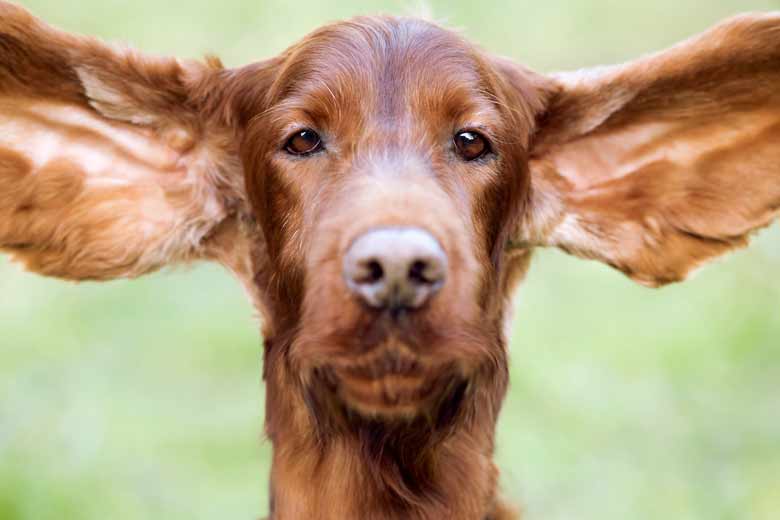
A sore ear is a common problem for dogs and cats. The design of dogs’ and cats’ ear canals is in an ‘L’ shape, this allows debris, wax and moisture to accumulate within the ear. Certain anatomical features and behaviours of some breeds can predispose them to being more likely to suffer ear problems:
- Cocker Spaniels – long “floppy” ears
- Cavalier King Charles Spaniel – excessive wax production
- Scottish Folds, Pugs, Shar Pei’s – ears with lots of folds
- Poodles and Poodle X’s – ears with lots of hair growing in the ear canal
- Labradors – love swimming and getting their ears wet
These features attribute to the “incubator” effect inside the ear canal.
Most commonly an ear infection is triggered first by an underlying allergy and then exacerbated by the above conditions.
A sore ear can be particularly distressing. An easily alleviated problem turns into something more serious with excessive scratching and head shaking.
Causes
There are many causes for ear problems, including injuries, bacterial infections, fungal (yeast) infections, grass seeds, dirt or sand, excessive wax production, soap or water in the ear canal, ear mites, allergies and other skin conditions.
Signs
Watch for one or more of the following signs:
- Scratching one or both ears
- Smelly ears
- Head shaking
- Head tilted to one side
- A discharge from the ear – it may be yellow, green, brown, black or cream
- Painful ears or head when touched
- Redness and inflammation of ear flap and ear canal
- Swelling of ear flap
- Stumbling or circling to one side
- Lethargy and depression
Diagnosis
Because most ear problems show the same signs, the ear canal and eardrum have to be examined with an otoscope for us to make a diagnosis. For example a grass seed in the ear may cause your dog to have exactly the same signs as a bacterial infection – we need to be able to see into the canals to tell the difference. The ear drum must be assessed, as a ruptured ear drum is a much more serious illness which can cause balance problems and inner ear infections.The medication we choose may be altered if the eardrum is ruptured. In some situations this exam is impossible unless the patient is anaesthetised – your Vet will decide what is best.
Sometimes a smear is taken and examined in our in-house laboratory to check the cause of the problem. Other times a sterile swab is taken and sent to a pathology laboratory to “grow” the bacteria or yeast that are causing an infection, and to determine the best treatment. Some dogs that have chronic recurring problems, have bacteria or fungi that are resistant to the common ear ointments and drops, and need different formulations to treat the infection. This can only be determined with microbiological culture and sensitivity testing.
Occasionally sedatives or general anaesthesia is required if the animal is particularly painful or aggressive.
Medication And Treatment
Medication may be given in the form of drops, ear cleaning solutions and tablets. It is ESSENTIAL that these treatments are used correctly. Your Veterinarian and Veterinary Nurse will show you how to properly administer ear medications. Intermittent use of antibiotic solutions can favour the multiplication of resistant bacteria. This is why we always prescribe the drops for a certain time and why a REVISIT is SO IMPORTANT to check the ears at the end of the course. If the ears aren’t 100%, then the problem will reoccur once the medication is stopped.
Sometimes more extensive treatment is necessary. For example an ear that is full of pus may need to be flushed under general anaesthesia, to remove as much discharge as possible and assess the ear drum. Or a foreign body must be removed under sedation or general anaesthesia to prevent rupture of the ear drum.
How Can I Prevent Ear Problems?
There are some things you can do to help prevent ear problems:
- Cut the hair around and inside the ear flap short to allow better circulation of air
- Get your groomer to pluck the ears regularly – caution though as doing this may inadvertently cause inflammation predisposing to an ear infection……
- Use an ear cleaner once or twice weekly, eg. Epiotic. A mild, non-irritating, cleansing and drying solution formulated to remove crusts and excessive wax. It may be used for routine cleansing in healthy ear canals or prior to administration of other ear infection treatments. It dissolves the wax and debris inside the ear and allows the dog or cat to shake it out. It also dries out the ear if your dog has been swimming or water has gone into the ear during a bath.
- Control allergies. Allergies often cause or contribute to ear problems, as the inside of the ear is lined with skin, and skin is usually the primary organ affected with allergies in dogs and cats.